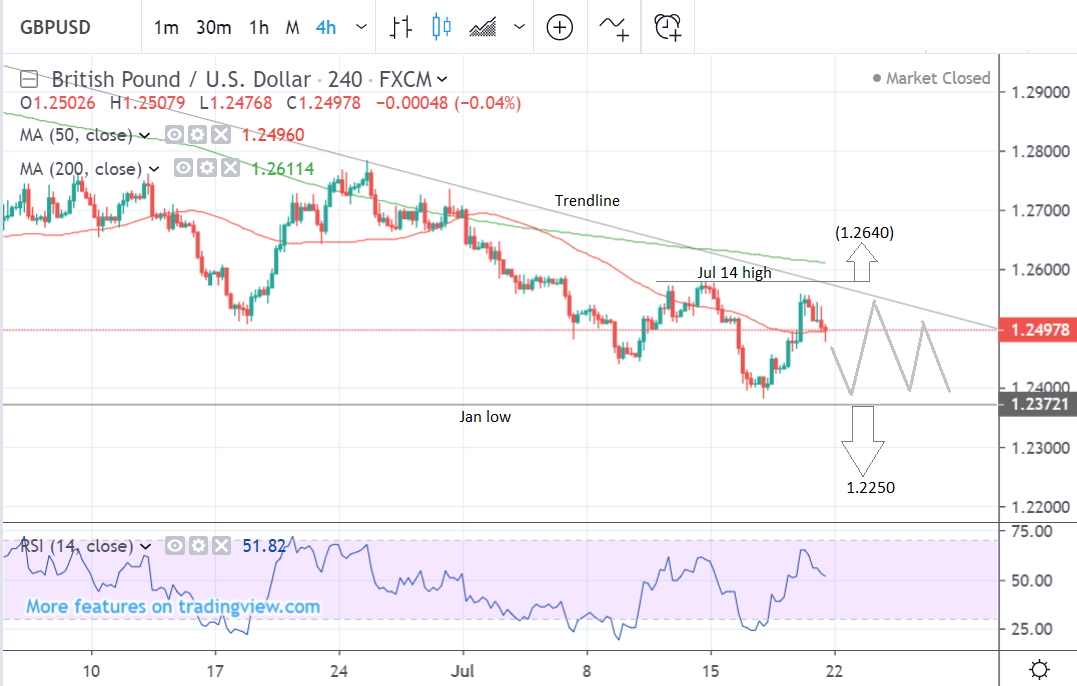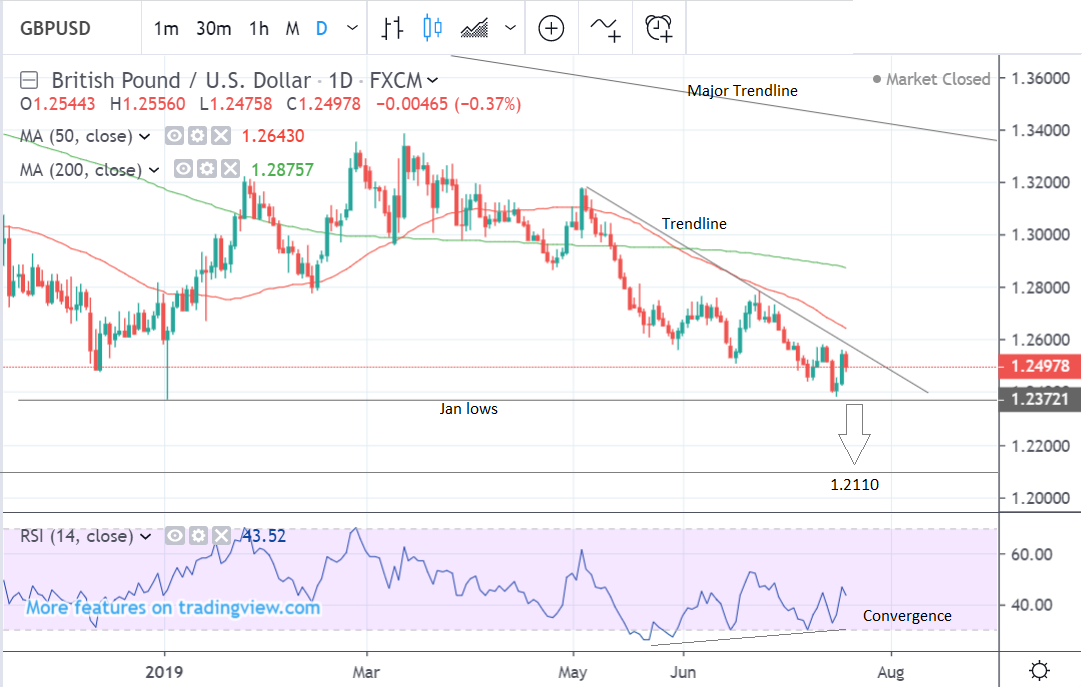The Pound-to-Dollar Rate in the Week Ahead: Charts Argue for More Downside

Image © Adobe Images
- GBP/USD rate remains locked in a downtrend on the charts.
- Finds significant support at Jan lows but the trend is still lower.
- New Prime Minister incoming for GBP as USD eyes GDP data.
The Pound-to-Dollar rate is set to begin trading around 1.2498 when the market opens after falling back to its January lows in the previous week, where Sterling has found significant support even if the overall trend is still to the downside.
Studies of the charts suggest the Pound-to-Dollar pair is at a crossroads. Although in a downtrend, a hard floor of support is underpinning the exchange rate near to it January lows. As such we see a probable sideways trend forming in the short-term, although the downside bias remains.
The 4 hour chart, which we use to determine the short-term outlook including the next 5 days, shows the pair having reached the 1.23 area on July 17 and then bouncing quite strongly to end the week just shy of 1.25.

Above: Pound-to-Dollar rate shown at 4-hour intervals.
Although the rebound looks quite strong it is still not evolved enough to indicate that the trend has changed and while we're at these historically low levels the established trend trumps all other considerations.
Nevertheless, more downside would be subject to confirmation from a clear break beneath the January low at the 1.2350 level.
Below 1.2350 the pair will then target 1.2250, at which point there's a possibility the exchange rate could rebound into a new uptrend. The trendline at about 1.2520 is likely to provide formidable resistance to an upward move.
Ideally, we would want to see a break above the July 14 high at 1.2580 for confirmation of a correction to the upside, which would then target the 1.2640 level that coincides with the 50-day moving average (MA) of prices.

Above: Pound-to-Dollar rate shown at daily intervals.
The daily chart shows how the pair has fallen to the January lows and bounced, but the overall trend is down and we expect that to remain the case. A break beneath January's lows and the 1.2350 level would probably green-light a move down to a target of 1.2110, which coincides with the March 2017 lows.
Momentum is not particular bearish and also suggests the trend could be turning. The relative-strength-index (RSI) indicator is converging bullishly with price and this, along with the fact the pair has touched a key support at the January lows, suggests bears should exercise caution.
The daily chart is used to provide an indication of the medium-term outlook, which includes the next month ahead.
Above: Pound-to-Dollar rate shown at weekly intervals.
The weekly chart, which we use to analyse the long-term outlook including the next few months, is suggesting the pair may be rotating into a move higher although the dominant downtrend remains intact.
The formation of a bullish hammer candlestick last week at the level of the January lows is a bullish sign and could indicate that the pair is about to start recovering off the hard floor provided by this key level. However, the overall bias is still to the downside, potentially extending as far down as the 1.1900 lows last seen at the end of 2016.
AA
The U.S. Dollar: What to Watch
The main event in the week ahead for the Dollar is second quarter GDP data, which is forecast to show the economy growing at an annualised pace of 1.8%, down from 3.1% in the opening quarter of the year.
The data is due out at 13.30 London time Friday and the result is likely to influence the Federal Reserve (Fed) as U.S. policymakers deliberate over whether the economy needs an ‘insurance’ rate cut to help support growth or not. A lower-than-expected result would ring alarm bells for the economy.
Above: Recent quarterly U.S. GDP growth rates.
A rate cut should hurt the Dollar in theory although the move has long been expected by the market so the currency response will be dictated largely by the Fed's guidance on future policy actions. Any hints of further rate cuts to come later in the year could weigh on the Dollar.
Housing data could also be key to the interest rate outlook given the impact that changes enacted by the Fed have on the mortgage market. Existing home sales are expected to have risen 0.2% in June when they are released on Tuesday at 15:00 London time.
New home sales are forecast to have risen 6.6% in June compared to a month ago when released on Wednesday at 15:00. This would be a considerable turnaround from the negative figure in May although the series does tend to be quite volatile.
The house price index for May is seen rising 0.3% compared to the previous month when the data is out at 14:00 Tuesday.
“The housing market will fall under the spotlight amid signs of renewed weakness in the sector...Data released in the past week showed housing starts declined in June, while building permits fell to a two-year low. More poor numbers on housing would strengthen the argument for bold policy action in July,” says Raffi Boyadijian, an economist at broker XM.com.
Manufacturing, services and composite PMIs for July are forecast to show rises when they are released at 14:45 Wednesday. The manufacturing PMI is expected to have risen to 50.9, from 50.6 previously, and services index is seen rising from 51.5 to 51.6. PMI’s are reliable indicators of growth so they will be watched closely by the market.
AA
The Pound: What to Watch
The major driver of the Pound this week is likely to be the announcement of the winner of the Conservative Party leadership election on July 22, but with little difference remaining between the two candidates' stated Brexit policies, the result may not cause as much volatility as previously expected.
Jeremy Hunt is seen as more ‘moderate’ and less likely to take the UK out of the EU without a deal, so his election might provide some relief for Sterling. The opposite is true of Boris Johnson, who is the bookmakers' favourite to win, although such an outcome is likely in the price of the Pound by now.
According to betting website oddschecker, Johnson's chances of winning have increased to 97.08%. On the data front the major release is the CBI Industrial Trends survey, which on Tuesday and a speech from Bank of England’s (BOE) chief economist Andy Haldane on the same day.
Andy Haldane is set to make a speech at 13.15 on Tuesday. The market will be keen to hear his views on the economy after recent mixed data. Previously the BOE had been one of the few major central banks not expected to cut interest rates, and was actually talking about raising them. Much depends on Brexit of course. Will Haldane continue to endorse a marginally hawkish stance, or is he going to turn more neutral? On Tuesday we shall see. If he changes his tune it could weigh on Sterling.
The CBI survey is usually closely followed because it provides timely insight into changing industrial trends. Industrial production unexpectedly plunged -2.7% in June and although it rebounded 1.4% in July it was a worrying result, and the worst since 2013. Investors will therefore be keen to see what the CBI data reveals when it is released on Tuesday at 11.00 BST and whether the sector is likely to see more declines in the future or not.
Above: Changes in UK industrial production. Source: Tradingeconomics.com.
Time to move your money? Get 3-5% more currency than your bank would offer by using the services of foreign exchange specialists at RationalFX. A specialist broker can deliver you an exchange rate closer to the real market rate, thereby saving you substantial quantities of currency. Find out more here. * Advertisement
